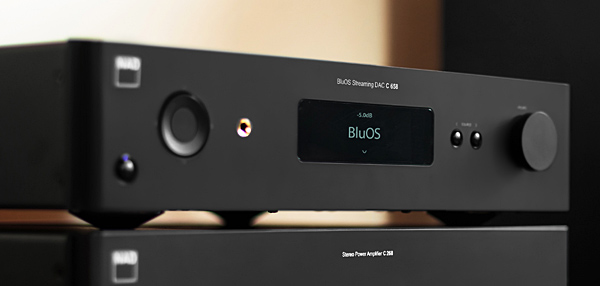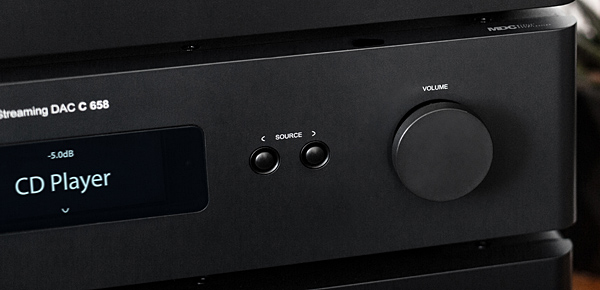NAD C 658 Network Audio Player/Preamplifier Review Page 2
Listening
My first round of critical listening with the C 658 was with Dirac Live disabled. Starting with CDs, I got into the spirit of the season by playing a track from John Zorn's A Dreamer's Christmas, a disarmingly straightforward interpretation of holiday classics by the eclectic NYC jazz composer. Playing the lounge-y "Winter Wonderland," the vibraphone had solid, well- rounded presence, and I heard clean separation between it and the ambient wash of chimes and sleigh bells in the background. Electric bass came across as full and clean, and a guitar solo revealed a crisp, yet sweet tone that provided a perfect complement to the vibraphone's warm, wooden sound.

Moving on to streaming, I cued up "I Want You (She's So Heavy)" from The Beatles' Abbey Road Special Deluxe Edition (24-bit/96kHz FLAC, Qobuz) in the BluOS app. This recent remix offers a greater abundance of everything— muscular McCartney bass, gritty Lennon vocals, dynamic Billy Preston Hammond organ flourishes, and crisp Harrison guitar leads. The C 658 delivered all of it in a transparent and highly satisfying manner.
Listening next to Marissa Nadler's "For My Crimes" (24/96 FLAC, Qobuz), I experienced a similar sense of spaciousness and high-precision layering that I heard on the John Zorn Christmas track. Nadler's folky vocals and acoustic guitar came across cleanly with just a hint of dryness, and both were perfectly centered in the mix amidst the massed strings and ghostly, disembodied background vocals. I did feel there was a slight treble edge to both the vocals and cello that I didn't remember hearing with the Cary Audio DMS-550 when I reviewed it, but with the DMS-550 no longer on hand for comparison, it was impossible to nail down that judgment.
Circling back to a lounge/ jazz vibe, I played "Hojder" by Danish duo Bremer/McCoy from their new release Utopia on David Byrne's Luaka Bop label (16/44 FLAC, Qobuz). The standup bass in this track had a meaty presence and was powerfully rooted in space. Electric keyboards had a crisp, yet ethereal quality that added a strong sense of height and depth to the presentation, and reverb trails were clearly defined. The combination of detail and warmth conveyed by the C 658 on this track was compelling—if it weren't for my hectic reviewing schedule, I would have continued to sit and listen to the full album straight through.
To test the NAD's phono stage, I spun tracks from a few LPs, including "Three More Days," from Ray LaMontagne's Till the Sun Turns Black (RCA) and "Lachesis" from Harmony Rockets with Peter Walker (Tompkins Square). The C 658's phono input had a low noise floor and did a service- able job laying down the beat and delivering Lamontagne's soulful vocals, and the same could be said for its handling of the psychedelic, raga-fueled atmospherics in the Harmony Rockets/Peter Walker track. When I played the same cuts using my Plinius Jarrah phono preamp, however, I felt that "Three More Days" in particular sounded livelier and less dynamically constrained in comparison with the C 658's own phono stage.

Dirac Live in Effect
To test the effects of Dirac Live room correction, I used two filters: the default one created by the app after my initial measurements were completed, and a second filter I labeled Xtra Bass that I had boosted at select frequencies. Listening to "I Want You (She's So Heavy)" and toggling the default filter on and off in the BluOS app's audio settings panel, McCartney's bass guitar sounded considerably cleaner, but also came across as too polite for my taste. When I applied the Xtra Bass filter, a good amount of the bass punch came back, and there was also a cleanliness to the presentation that revealed Paul's surprisingly fancy fretwork on this track— something I had not previously appreciated.
Listening to Bremer/McCoy with Dirac Live switched on and off, I didn't experience the same absence of bass I heard with The Beatles when the default filter was applied, but I also continued to prefer the sound with the Xtra Bass filter. With Dirac Live switched off, standup bass on this track had a somewhat bloated quality in comparison with the filtered presentation, which was more balanced and retained bass warmth while eliminating boom.

Conclusion
How does NAD's $1,649 network audio player/preamplifier hold up against its high-end competition? I'd say extremely well. The C 658 offers most of the features you'd want in a component of this type, including high-res streaming, MQA support for Tidal playback, and AirPlay/aptX HD Bluetooth. Add Dirac Live room correction to that list, with all features controlled by NAD's very capable and refined BluOS app. Also, it has plenty of digital and analog connection options, including moving magnet phono, and can be upgraded with HDMI inputs. The only other thing I'd ask of the C 658 is for it to be Roon Ready, though I imagine that won't be a deal- killer for many people.
Overall, I found myself very impressed with the C 658's sound and was also pleased with the performance of the C 268 stereo amplifier that the company also sent along. At around $2,549, this pair makes for a very appealing package. Are there ways in which the C 658 comes up short in comparison with pricier streaming preamps? While I found the NAD's vinyl playback to be serviceable, the Simaudio Moon 390's handling of the same proved to be every bit the equal of my reference phono rig when I reviewed it. And while the C 658 provides only limited DSD support (converted DSD playback only using the BluOS desktop app), the Cary Audio DMS-550's performance with DSD was one of its primary strengths. But again, both those components cost more than five grand while the C 658 is priced at a level many audiophile will be able to afford. Great sound, useful features, great price—what's not to like?





























































